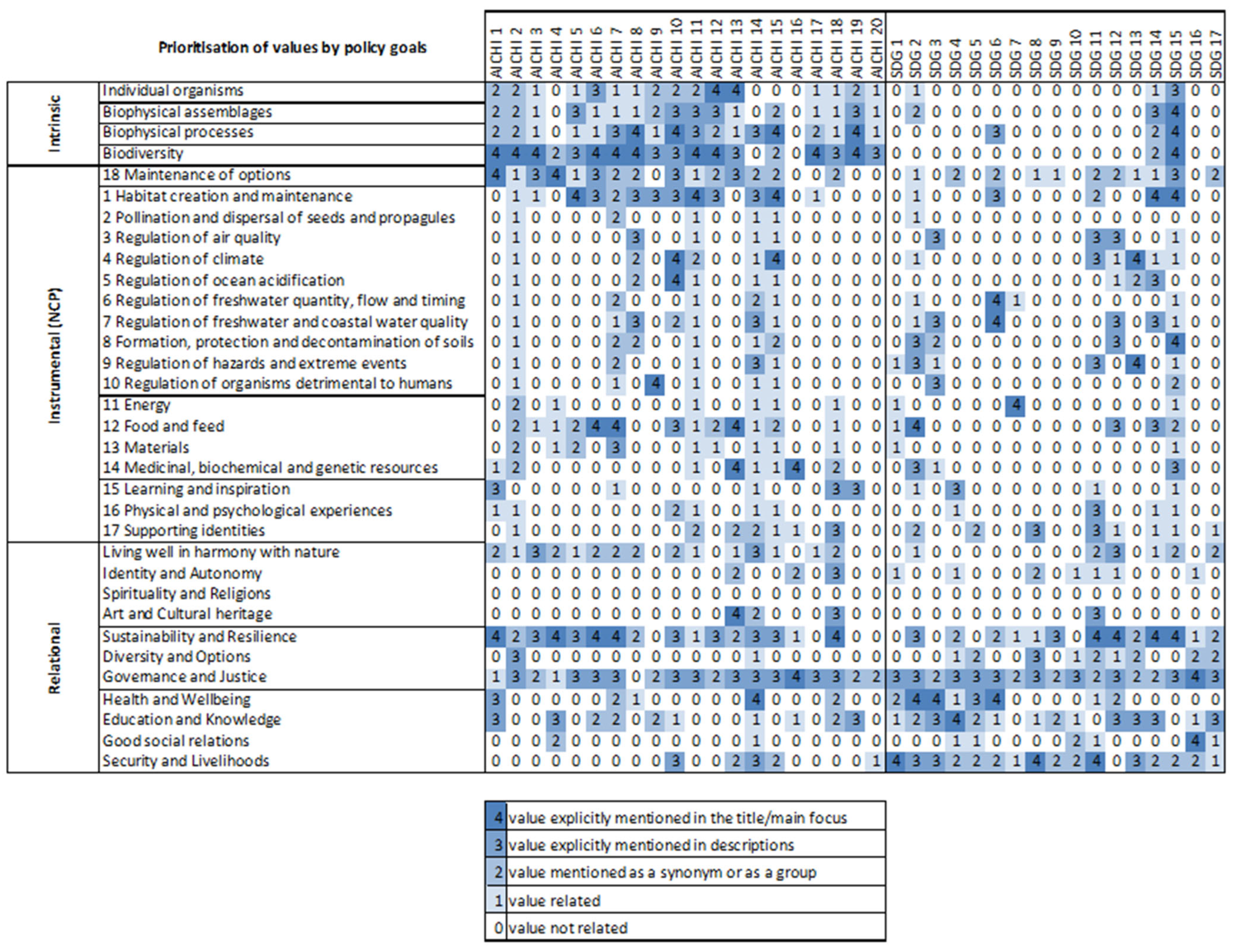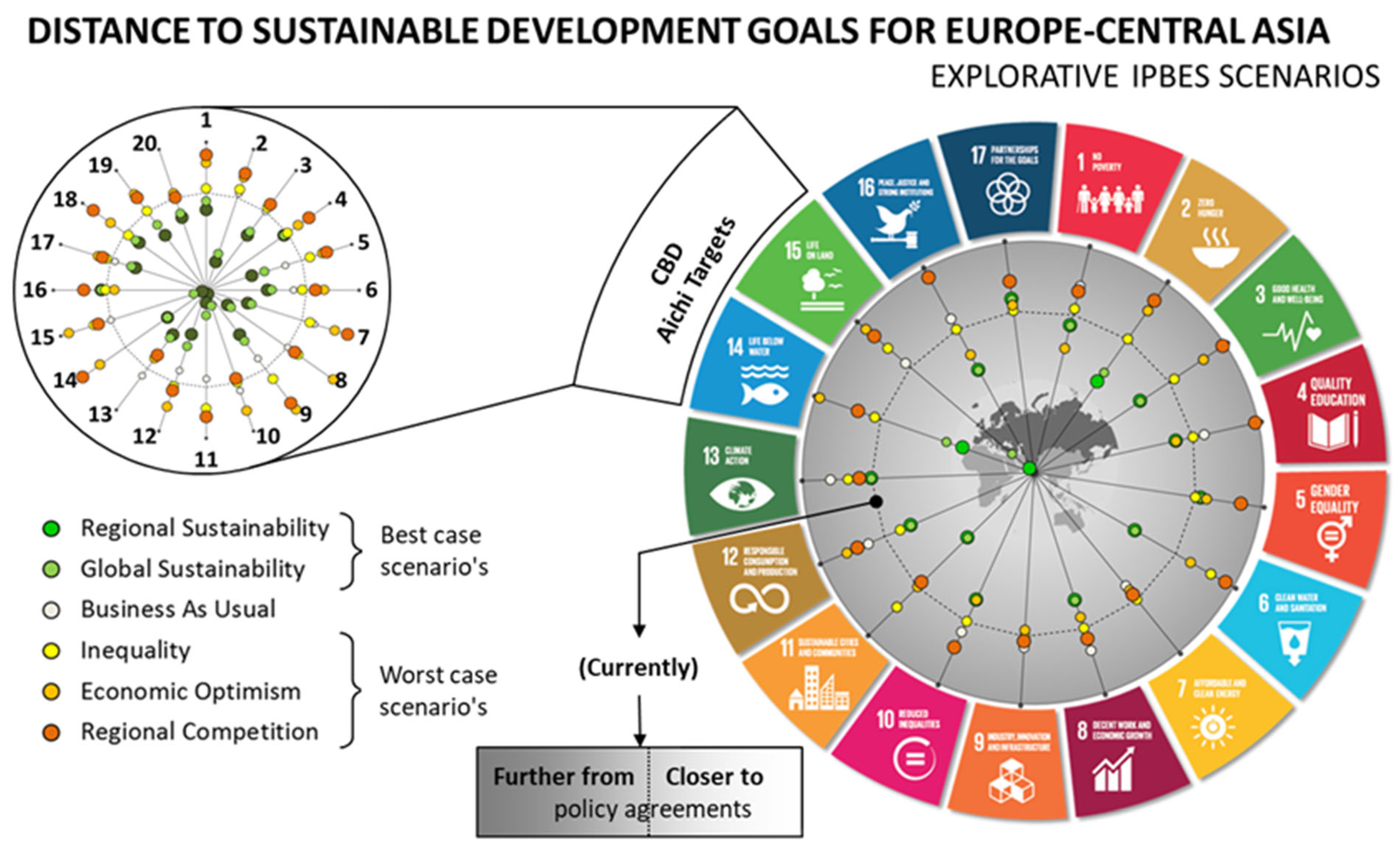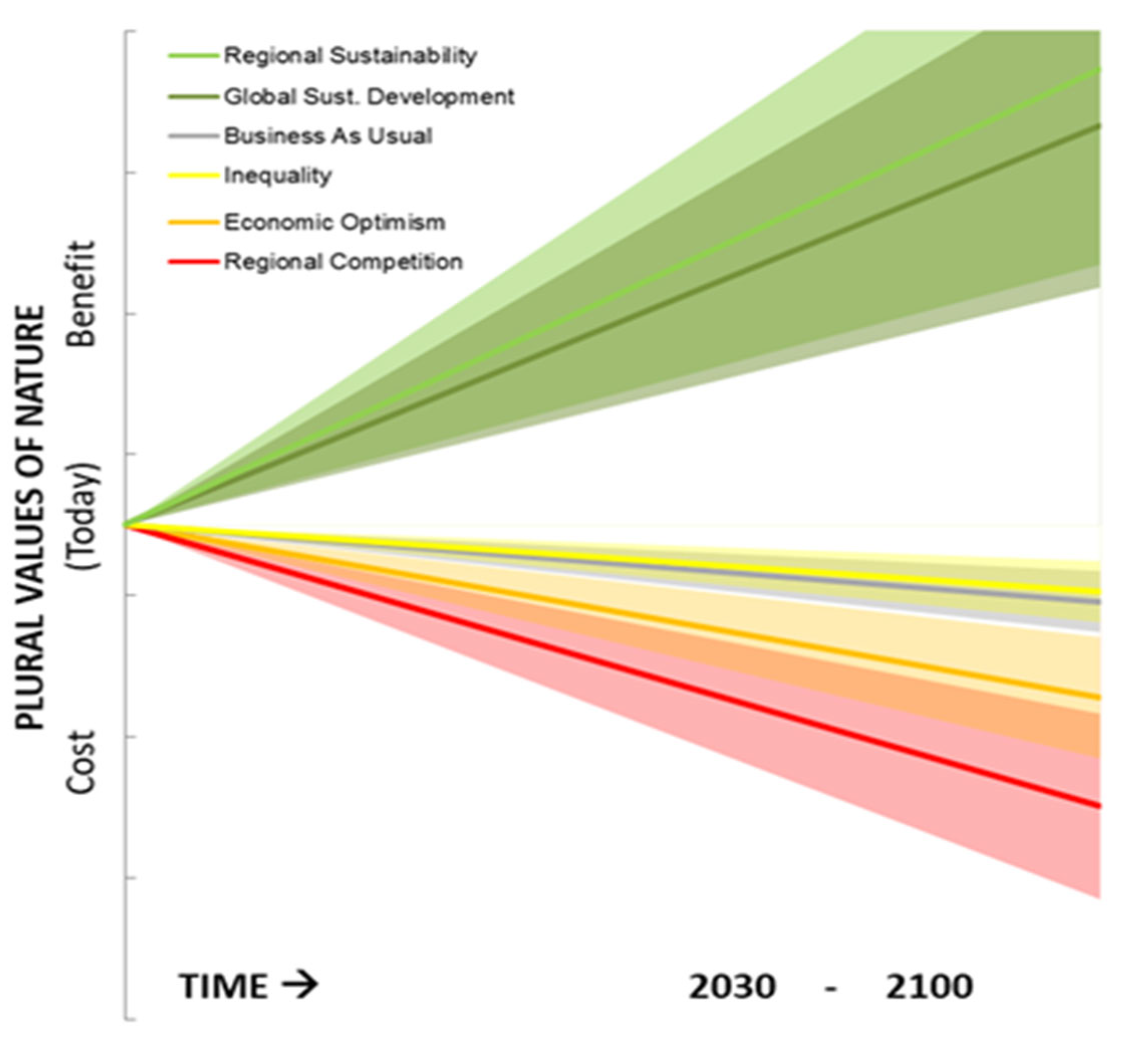Transformative Change Needs Direction
Abstract
1. Introduction
2. Connecting Policy Goals and Scientific Assessments
3. Plausible Futures for Europe and Central Asia
- Business as usual
- Continuation of current social, economic, and technological trends results in moderate but uneven population and economic growth, with persisting inequality and societal stratification. International markets and institutions are mostly stable but function imperfectly. Environmental issues are perceived as necessary, but society and industry are reluctant to adopt environmental policies that would lead to substantial improvements.Economic optimism
- Global developments steered by high economic growth across the majority of European countries result in a strong dominance of international markets with a small degree of regulation and a high level of international cooperation. Technological development is rapid, with a focus on efficiency. Lifestyles are resource intensive, and a reactive attitude toward environmental management prevails.Regional competition
- Social fragmentation, competition, and the failure of market mechanisms result in inequality, declining social cohesion, and decreases in human capital across Europe and Central Asia. Violence and instability challenge international trade and cooperation, leading to a shift toward self-sufficiency.
- Inequality
- Power becomes concentrated in a relatively small elite across the globe, leading to increasing economic, political, and social inequalities and fragmentation both across and within countries. There are increasing disparities in economic opportunity, leading to substantial proportions of the population of Europe and Central Asia having a low level of development. Political regimes in Central Asia become increasingly authoritarian and repressive, with a growing incidence of social unrest, conflicts, and ethnic clashes.Global sustainable development
- A high degree of international cooperation and top-down governance results in a globalized world with a high level of proactive regulation in favor of the environment. Technological development is rapid, focusing on green and resource-efficient technologies, biotechnology, and sustainable technologies. High levels of social respect and cohesion lead to substantial increases in human and social capital and low material consumption.Regional sustainability
- Decision making shifts toward local and regional levels with a focus on welfare, equality, and environmental protection delivered through local solutions. A proactive attitude to environmental management prevails, increasingly influenced by environmentally aware citizens. International collaboration is weak, causing problems with technology transfers and obstructing coordination to solve global issues such as climate change.
4. Projecting Achievement of Policy Goals in Plausible Futures: Methodology
- The IPBES plural value typology is used as a framework for an integrated analysis and evaluation. The detailed description is found in Table S1 (Supplementary Material C1). This framework is further underpinned by the recent IPBES Methodological Assessment on Diverse Values and Valuation of Nature, which concludes that the use of one single indicator (whether economic, e.g., dollars, or ecologic, e.g., red list species status) provides a too narrow view on the diverse values of nature [13]. Our analysis therefore departed from the 28 “value targets” (here: indicators) already applied in the ECA and Global assessment.
- From the IPBES ECA assessment review, we know what the modeled impacts of each plausible future scenario are on each of the 28 value indicators. These impacts are qualified, including their confidence level, based on the number of studies and the consistency of the model outputs.
- Not all values are equally important for society. The normative benchmark for weighing the indicators in this evaluation are the SDGs and Aichi targets, which reflect a global consensus of how humanity envisions nature (Aichi) and our use of natural resources (SDGs). A quantitative content analysis of which of the 28 value indicators are prioritized by the SDGs and Aichi targets provides us with the overall societal importance of each value indicator (see Supplementary Material C3). For instance, the Aichi targets put more weight on the value indicators in the intrinsic category, while the SDGs emphasize the relational values, and the instrumental values are emphasized in several Aichi targets and SDGs (see Figure 2 and Supplementary Material C3).
- A given scenario has an impact on a certain value indicator (derived from the review), and this indicator reflects to a certain extent the policy priorities institutionalized through the SDGs and ATs (weight derived from the policy documents). Adding up the weighted value indicators results in a negative “cost” or positive “benefit” contribution to the reaching of the targets. Aggregating the negative and positive contributions of all the targets per scenario results in a total value compared to the current situation.
5. Scenarios Differ in their Sustainability and Biodiversity Conservation Impacts
6. A Plural Costs–Benefits Projection Points out a Clear Direction
7. Discussion and Conclusions
Supplementary Materials
Author Contributions
Funding
Institutional Review Board Statement
Informed Consent Statement
Acknowledgments
Conflicts of Interest
References
- IPBES. Global Assessment Report on Biodiversity and Ecosystem Services of the Intergovernmental Science-Policy Platform on Biodiversity and Ecosystem Services; IPBES Secretariat: Bonn, Germany, 2019. [Google Scholar]
- Brundtland, G. Report of the World Commission on Environment and Development: Our Common Future; United Nations General Assembly Document A/42/427; United Nations: Geneva, Switzerland, 1987. [Google Scholar]
- UN. Convention on Biological Diversity of 5 June 1992 (1760 U.N.T.S. 69). Available online: https://cil.nus.edu.sg/databasecil/1992-convention-on-biological-diversity/ (accessed on 20 September 2022).
- IPBES. The IPBES Regional Assessment Report on Biodiversity and Ecosystem Services for Europe and Central Asia; IPBES Secretariat: Bonn, Germany, 2018. [Google Scholar] [CrossRef]
- Rounsevell, M.D.A.; Metzger, M.J. Developing qualitative scenario storylines for environmental change assessment. WIREs Clim. Chang. 2010, 1, 606–619. [Google Scholar] [CrossRef]
- Priess, J.; Hauck, J. Integrative Scenario Development. Ecol. Soc. 2014, 19, 12. [Google Scholar] [CrossRef]
- Kok, K.; Pedde, S.; Gramberger, M.; Harrison, P.A.; Holman, I.P. New European socio-economic scenarios for climate change research: Operationalising concepts to extend the shared socio-economic pathways. Reg. Environ. Chang. 2018, 19, 643–654. [Google Scholar] [CrossRef]
- Gallopin, G.; Hammond, A.; Raskin, P.D.; Swart, R. Branch Points: Global Scenarios and Human Choice; Stockholm Environment Institute (SEI): Stockholm, Sweden, 1997. [Google Scholar]
- Hunt, D.V.L.; Lombardi, D.R.; Atkinson, S.; Barber, A.R.G.; Barnes, M.; Boyko, C.T.; Brown, J.; Bryson, J.; Butler, D.; Caputo, S.; et al. Scenario Archetypes: Converging Rather than Diverging Themes. Sustainability 2012, 4, 740–772. [Google Scholar] [CrossRef]
- Van Vuuren, D.P.; Kok, M.T.; Girod, B.; Lucas, P.L.; de Vries, B. Scenarios in Global Environmental Assessments: Key characteristics and lessons for future use. Glob. Environ. Chang. 2012, 22, 884–895. [Google Scholar] [CrossRef]
- Harrison, P.A.; Harmáčková, Z.V.; Karabulut, A.A.; Brotons, L.; Cantele, M.; Claudet, J.; Dunford, R.W.; Guisan, A.; Holman, I.P.; Jacobs, S.; et al. Synthesizing plausible futures for biodiversity and ecosystem services in Europe and Central Asia using scenario archetypes. Ecol. Soc. 2019, 24, 27. [Google Scholar] [CrossRef]
- Rounsevell, M.D.A.; Harfoot, M.; Harrison, P.A.; Newbold, T.; Gregory, R.D.; Mace, G.M. A biodiversity target based on species extinctions. Science 2020, 368, 1193–1195. [Google Scholar] [CrossRef] [PubMed]
- IPBES. Summary for Policymakers of the Methodological Assessment of the Diverse Values and Valuation of Nature of the Intergovernmental Science-Policy Platform on Biodiversity and Ecosystem Services; Pascual, U., Balvanera, P., Christie, M., Baptiste, B., González-Jiménez, D., Anderson, C.B., Athayde, S., Chaplin-Kramer, R., Jacobs, S., Kelemen, E., et al., Eds.; IPBES Secretariat: Bonn, Germany, 2022; 37p. [Google Scholar] [CrossRef]
- Mace, G.; Barrett, M.; Burgess, N.D.; Cornell, S.E.; Freeman, R.; Grooten, M.; Purvis, A. Aiming higher to bend the curve of biodiversity loss. Nat. Sustain. 2018, 1, 448–451. [Google Scholar] [CrossRef]
- Sachs, J.D.; Schmidt-Traub, G.; Mazzucato, M.; Messner, D.; Nakicenovic, N.; Rockström, J. Six transformations to achieve the Sustainable Development Goals. Nat. Sustain. 2019, 2, 805–814. [Google Scholar] [CrossRef]
- Soergel, B.; Kriegler, E.; Weindl, I.; Rauner, S.; Dirnaichner, A.; Ruhe, C.; Hofmann, M.; Bauer, N.; Bertram, C.; Bodirsky, B.L.; et al. A sustainable development pathway for climate action within the UN 2030 Agenda. Nat. Clim. Chang. 2021, 11, 656–664. [Google Scholar] [CrossRef]
- Kivimaa, P.; Kern, F. Creative destruction or mere niche support? Innovation policy mixes for sustainability transitions. Res. Policy 2016, 45, 205–217. [Google Scholar] [CrossRef]
- Loft, L.; Mann, C.; Hansjürgens, B. Challenges in ecosystem services governance: Multi-levels, multi-actors, multi-rationalities. Ecosyst. Serv. 2015, 16, 150–157. [Google Scholar] [CrossRef]
- Horan, D. A new approach to partnerships for SDG transformations. Sustainability 2019, 11, 4947. [Google Scholar] [CrossRef]
- Bouwma, I.; Schleyer, C.; Primmer, E.; Johanna, K.; Berry, P.; Young, J.; Carmen, E.; Jana, Š.; Bezák, P.; Preda, E. Adoption of the ecosystem services concept in EU policies. Ecosyst. Serv. 2018, 29, 213–222. [Google Scholar] [CrossRef]
- Erjavec, K.; Erjavec, E. ‘Greening the CAP’-Just a fashionable justification? A discourse analysis of the 2014–2020 CAP reform documents. Food Policy 2015, 51, 53–62. [Google Scholar]
- Winkel, G.; Sotirov, M. Whose integration is this? European forest policy between the gospel of coordination, institutional competition, and a new spirit of integration. Environ. Plan. C Gov. Policy 2016, 34, 496–514. [Google Scholar] [CrossRef]
- Froese, R.; Quaas, M. Rio+20 and the reform of the Common Fisheries Policy in Europe. Mar. Policy 2012, 39, 53–55. [Google Scholar] [CrossRef]
- Van Soest, H.L.; van Vuuren, D.P.; Hilaire, J.; Minx, J.C.; Harmsen, M.J.; Krey, V.; Popp, A.; Riahi, K.; Luderer, G. Analysing interactions among Sustainable Development Goals with Integrated Assessment Models. Glob. Transit. 2019, 1, 210–225. [Google Scholar] [CrossRef]
- Kubiszewski, I.; Costanza, R.; Anderson, S.; Sutton, P. The future value of ecosystem services: Global scenarios and national implications. Ecosyst. Serv. 2017, 26, 289–301. [Google Scholar] [CrossRef]




Publisher’s Note: MDPI stays neutral with regard to jurisdictional claims in published maps and institutional affiliations. |
© 2022 by the authors. Licensee MDPI, Basel, Switzerland. This article is an open access article distributed under the terms and conditions of the Creative Commons Attribution (CC BY) license (https://creativecommons.org/licenses/by/4.0/).
Share and Cite
Jacobs, S.; Santos-Martín, F.; Primmer, E.; Boeraeve, F.; Morán-Ordóñez, A.; Proença, V.; Schlaepfer, M.; Brotons, L.; Dunford, R.; Lavorel, S.; et al. Transformative Change Needs Direction. Sustainability 2022, 14, 14844. https://doi.org/10.3390/su142214844
Jacobs S, Santos-Martín F, Primmer E, Boeraeve F, Morán-Ordóñez A, Proença V, Schlaepfer M, Brotons L, Dunford R, Lavorel S, et al. Transformative Change Needs Direction. Sustainability. 2022; 14(22):14844. https://doi.org/10.3390/su142214844
Chicago/Turabian StyleJacobs, Sander, Fernando Santos-Martín, Eeva Primmer, Fanny Boeraeve, Alejandra Morán-Ordóñez, Vânia Proença, Martin Schlaepfer, Lluis Brotons, Robert Dunford, Sandra Lavorel, and et al. 2022. "Transformative Change Needs Direction" Sustainability 14, no. 22: 14844. https://doi.org/10.3390/su142214844
APA StyleJacobs, S., Santos-Martín, F., Primmer, E., Boeraeve, F., Morán-Ordóñez, A., Proença, V., Schlaepfer, M., Brotons, L., Dunford, R., Lavorel, S., Guisan, A., Claudet, J., Harmáčková, Z. V., Liekens, I., Hauck, J., Kok, K., Zinngrebe, Y., Pedde, S., Czúcz, B., ... Harrison, P. A. (2022). Transformative Change Needs Direction. Sustainability, 14(22), 14844. https://doi.org/10.3390/su142214844










